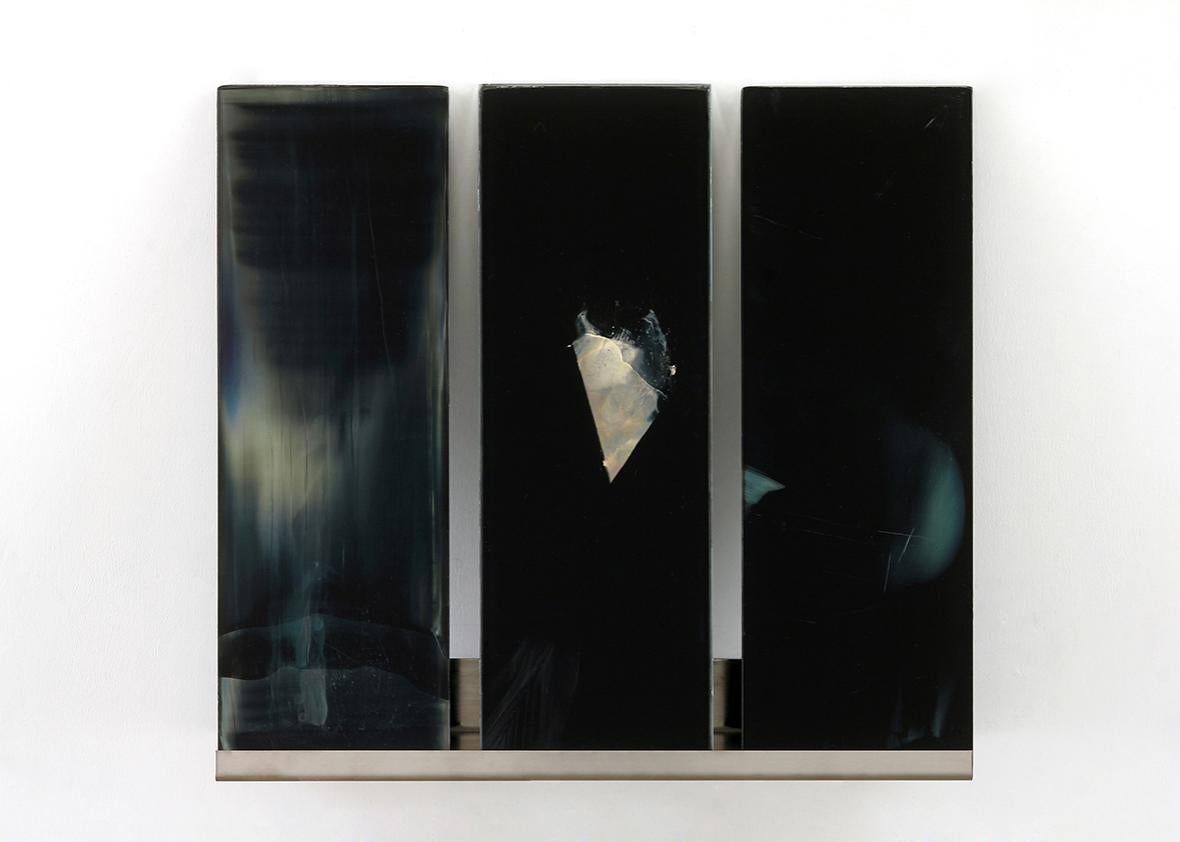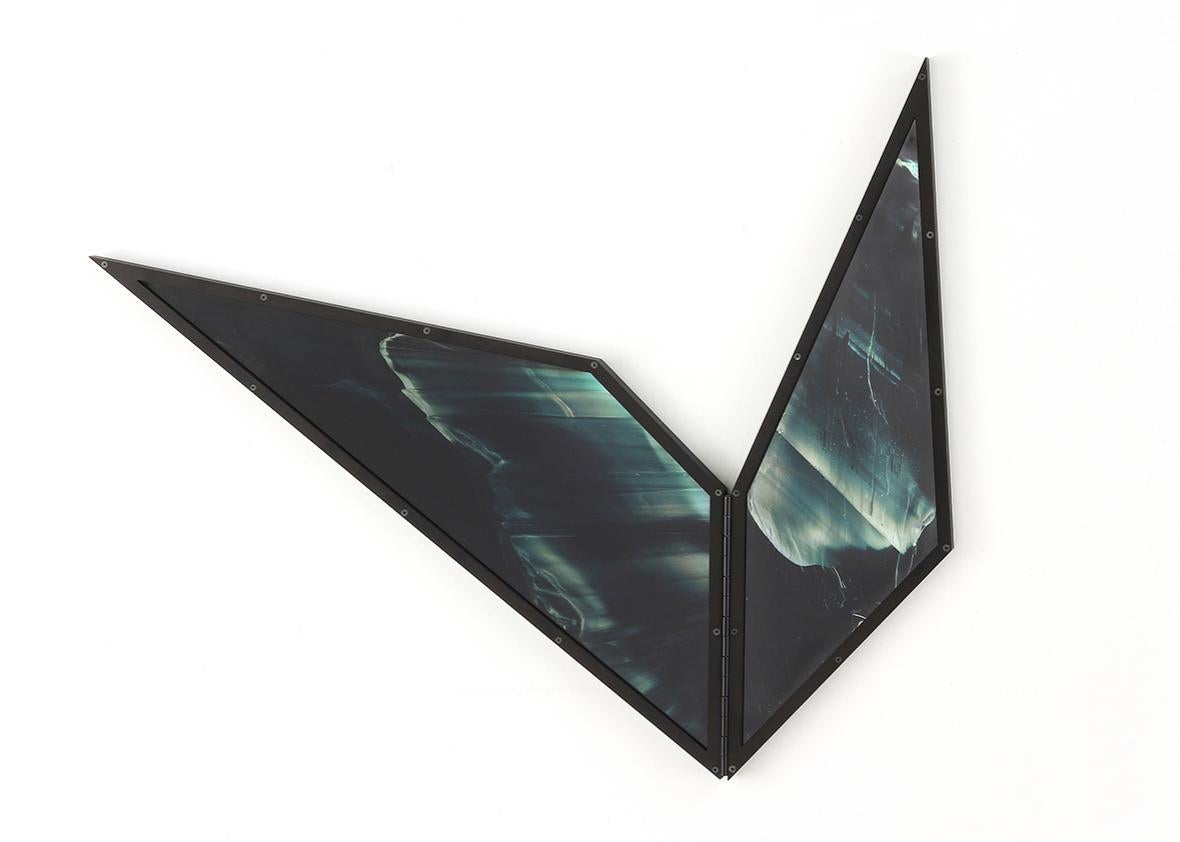Kate Nichols is doing something very new—and very old.
The former painter’s apprentice is the first artist-in-residence at the Alivisatos Lab, a nanoscience laboratory at UC–Berkeley. She’s made art out of silver nanoparticles, compared Victorian mirror-making technology with today’s nanotechnology, and has grown cellulose from bacteria. Her newest project explores mimesis, or lifelike replication, in both 15th-century paintings and synthetic biology. That work may seem dazzlingly high-tech, but she says it’s in keeping with the most ancient of artistic traditions: creating something new by making materials out of the world around.
Can you tell me a bit about your background as an artist?
Sure. In my early 20s, I studied as a painter’s apprentice, and studied painting and paint-making, particularly those that grew out of Northern Europe.
How did you move from that to using nanomaterials in your art?
It was sort of an organic process that began years before I started working with these materials. It was inspired by two things. One was, I’ve always been intrigued by artists who made their own materials. Going back to early cave painters—the practice of making art didn’t begin with making images, but with selecting and modifying and refining the materials to make art with. When I was studying these Renaissance-era methods of making paint—practicing with these methods, making my own paints in my studio—I began thinking that in many ways, it was sort of like a historical re-enactment. I was using these methods that were developed by these people back in the 1400s. As a person who’s interested in this tradition of painting, what does it mean to be building on that tradition in the 2000s? So I was thinking, well, it seems like the next step would be to develop my own materials that speak to me in my time, with things that they didn’t have access to then.
The second is that back in college, I had to take some sort of quantitative class. I took a math class that I was really fascinated by—modeling biological growth and form. It was taught by a mathematician at Kenyon named Judy Holdener, and Judy studied art before she switched to math. We ended up doing independent study together, and she taught me about the morpho butterfly, which is sort of a poster child for structural color. Having been a painter’s apprentice, I sort of fancied myself a young expert in color. But encountering this butterfly made me realize I had so much more to learn. Color can be generated in other ways than pigmentation. But to create structural color you had to operate on such a small scale. It seemed impossible. But as the years went on I started hearing feature stories about nanotechnology. And I realized these are the people who can create things that small. And that’s how I got the idea.

Donald Felton
Could you tell me a bit more about structural color?
We think of color as being generated chemically. Things are certain colors because of what they’re made of. That describes pigmental color. But color can also be generated structurally when you have features small enough to interfere with wavelengths of visible light. At the nanoscale, for example, you can create color by changing the shape, size, and embedding environment of the material. It’s color by design.
And how did you learn what you needed to about nanotech?
It was a process that was very similar to being a painter’s apprentice. I had the wonderful good fortune of being invited into the Alivisatos lab at UC–Berkeley [which researches nanotechnology] and to work full-time with the scientists at the lab. I would follow students around, ask them lots of questions, try to repeat what they would do, make lots of mistakes, and eventually pick things up. I can’t stress enough how generous my labmates were with me in mentoring me. I didn’t have any science background at all. No chemistry past sophomore year of high school.
So you went from no background in science to being artist in residence at a nanoscience lab, Alivisatos?
More artist in absentia now. I’m very much in this phase of harvesting the years of years of research and developing these materials. That was a multiyear process where I was in the lab all day, every day. Now I’m kind of reaping the rewards of that. I’m focused on creating with these materials and exploring them on a more creative level instead of wrestling with them on a technical level.
Which goes back to what you said the earliest artists did.
Yeah, exactly.
How can art help people understand nanotechnology?
People tend to talk about nanotechnology as if it’s new and belonging to the realm of the future and the speculative. But it’s not new. In fact, it’s very old. And I’m interested in nanotech’s long history, which is a history that began with artists. Medieval stained glass window–makers created nanoparticles to bring rich colors to the glasses. Ninth-century Tunisian ceramists, they were creating these sophisticated matrices that give ceramic tiles a rich luster. These examples speak to the intertwined history of art and science. Artists and craftsmen played a role in the emergence of science as experimental practice, as opposed to a text-based inquiry.* Artists and craftsmen engaged directly with the physical world. They were making things. They were the first people interested in measuring things, in creating reproducible results. Engaging with these nanomaterials puts me deeper into painting. It’s made me feel more connected with what it means to be a painter in all its facets.
I used to have a very un-nuanced understanding of color. I could easily ask the question, of an object, What color is it? But working with these nanomaterials doesn’t allow me to ask such simple questions anymore. Right now I’m in my studio, and I’m looking at a piece of glass with nanoparticles on it. And when I hold it up to the window, I’m seeing oranges, yellows, some reds. When I put it down to look at the dark floor so that it’s just reflecting light, I’m seeing blues and purples and greens. So that question sort of collapses. What color is it? It’s not that simple. And that’s been transformative for me as a painter. I still work in traditional oils, and if you look at my paintings before and my paintings after—it’s completely changed how I see, how I paint.
Is there a piece of yours that you think most exemplifies this?
When people started getting interested in the work I make with nanoparticles, I got the sense they were interested because it was new, it was nano. The future. Very quickly I started turning that on its head and saying, No, it’s very old. Art and science have this long, intertwined history. But I didn’t want to just talk about that. I wanted it to be present in the work. So I would pair my works that I make with silver nanoparticles with other works that I make with silver mirroring techniques developed by the Victorians. And what’s interesting is that many of these old recipes that Victorian-era artists and craftsmen developed for making mirrors and photographs—they’re chemically very similar to many of the processes I use to synthesize silver nanoparticles. For me it was a way for people could look at these things and see them together.

Donald Felton
What’s next for you?
Now I’m working on a project I’m really excited about. I’m digging back into these methods of painting I said I’d learned in my 20s. I’m making my own paints from pigments using 15th-century methods. I’m particularly interested in a lot of the fears about very lifelike painting. Early Christian theologians were very troubled by it because they thought it rivaled God’s own creation. They worried that painters who painted these very lifelike things were infringing on God’s powers to create and destroy.
I think this really echoes a lot of contemporary fears about nanotechnology and biotechnology. It puts these fears on a continuum. I’m working with a butterfly native to San Francisco where I live and was the first North American butterfly to go extinct due to urbanization. And now it’s being considered for de-extinction, which we haven’t realized yet, but many scientists are engaged in being able to bring back once-extinct species. Being an artist who’s interested in mimesis, what are the tools available to the artist now?* How can I bring these new tools to play in a very old conversation about what it means to be human? What it means to create?
It’s changed my teaching, too. I taught a painting class at the San Francisco Art Institute, and I talked to my students about how painters were in many ways early material scientists. I encourage them to make their own materials. And now I’m teaching a collage course, and I’m getting them to think about what does it mean to work with collage in 2016. [Pablo] Picasso and [Georges] Braque were pasting bits of newspaper into their painting—that was considered very daring. But now, as a class, we’re working with a scientist using CRISPR to cut and paste DNA. How can we take these older conversations and work with them with the techniques and technologies available to us now?
This interview has been edited and condensed for clarity.
Correction, Sept. 20, 2016: This article originally misquoted Kate Nichols as saying, “Artists and craftsmen played a role in the emergence of science as experimental practice, as opposed to a text-based inquiry history.” She said, “text-based inquiry.” The article also originally misquoted two sentences in response to the question of “What’s next for you?” One incorrect sentence was removed, and the other was updated to remove the incorrect language.
This article is part of the nanotechnology installment of Futurography, a series in which Future Tense introduces readers to the technologies that will define tomorrow. Each month, we’ll choose a new technology and break it down. Future Tense is a collaboration among Arizona State University, New America, and Slate.
